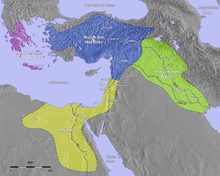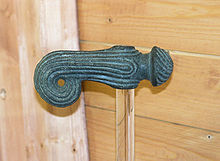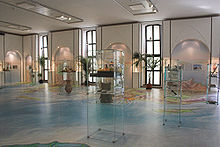Ship from Uluburun
Coordinates: 36 ° 7 '43.39 " N , 29 ° 41' 8.7" O
The ship of Uluburun is the wreckage of a freighter that was built in the 14th century BC. It sank off the southwest coast of Turkey and was rediscovered by sponge divers in 1982 . The unique find provides important information about the economy and trade in the Levant at the end of the Bronze Age . The salvaged ship cargo is exhibited today in the Museum of Underwater Archeology in Bodrum . The name derives from the place where it was found, Cape Uluburun near Kaş in the Turkish province of Antalya .
Site and discovery
The headland Uluburun (also Ulu Burun ) protrudes 8.5 km southeast of Kaş into the sea and is a popular place with amateur divers. The cargo ship from the 14th century BC lies 60 m off its eastern coast . Chr. On the seabed. In 1984, diving work began on the ancient ship to retrieve archaeological finds. During the work, the wreck finally drifted to a depth of 61 m. The recovered finds can be viewed in the underwater museum in Bodrum .
Scope of recovery
The first objects found turned out to be so-called ox skin bars. This is used to describe ancient raw copper plates , the shape of which is reminiscent of the dried skins of oxen, a common and widespread shape for transporting metal at the time, which should have made it easier to carry or attach to pack animals and on ships. The recovery of other finds was made difficult by the location on a slope at a depth of up to 60 meters and thus extended to the period from 1984 to 1994. In total, more than 22,000 dives with over 6,600 diving hours were necessary. American and Turkish researchers were involved, led by underwater archaeologist George Fletcher Bass from Texas A&M University (Institute of Nautical Archeology, INA) and his Turkish colleague Cemal Pulak .
The recovery was completed after ten years, but the scientific analysis and conservation of the enormous wealth of finds has continued to this day.
Dating
Through the artifacts , especially the Mycenaean ceramics , the time of the sinking could be dated to the late Bronze Age, more precisely to the late Helladic III A2. In absolute chronology, this corresponds to the second half of the 14th century BC. Chr . The radiocarbon dating and dendrochronology also have v at the end of the 14th century. Chr. A Nefertiti scarab (approx. 1360–1335 BC) refers to the same period and represents a terminus ante quem non , ie the ship cannot have sunk before the reign of Nefertiti.
The political situation at the time of the downfall
The world of states in the eastern Mediterranean at the time of the ship's sinking was in a state of constant change: the Hittites were on the advance and ruled large parts of Anatolia ; they expanded in the direction of the Levant with the northern port cities such as Ugarit . The kingdom of Mittani was around 1335 BC. Inferior to the Hittite Empire and incorporated by it. The great opponents of the Hittites were the Egyptians of the New Kingdom , more precisely the 18th Dynasty, who for their part had occupied the southern part of the Levant with the Phoenician cities of Byblos , Sidon , Tire and others. The Egyptians were on the defensive against the Hittites and had lost parts of Syria. The Assyrian Empire was formed to the southeast of the Hittite Empire in Mesopotamia , and the Babylonian Empire even further south . The Greek mainland in the west, the islands in the Aegean Sea and a small part of western Anatolia were part of the Mycenaean culture . Between Crete (Egyptian: Keftiu ) and the Greek mainland and Egypt existed at the latest since Thutmose III. intensified trade links.
Lost property and classification
The ship had 354 copper ingots in ox-hide form ( oxhide ingot ) and 121 plano-convex (bread-loafing) (a total of about 10 tons.) Tin (about 1 ton), blue glass (about 350 kg), oaks - resin , ebony and ivory on board. In addition, were acorns , almonds , figs , olives , pomegranates , pottery and jewelry made of gold and silver , bronze tools and weapons found on board.
Most of the items were apparently intended for export, while others were personal property of the crew or ship equipment. Little by little, ceramics and jewelry from the Canaanite city-states of the Levant , jewelry and glass from Egypt , copper from Cyprus (the origin could be determined by lead isotope analysis; copper established the flourishing of the Cypriot culture), cylinder seals from Assur , an Egyptian seal in Scarab shape, weapons and ceramics from the Mycenaean region, a sword and possibly also lance tips from Sicily and even amber from the Baltic Sea . The latter is the first evidence that a trade connection existed so early. The goods were mostly transported in amphorae and pithoi . Three pithoi were filled with pottery from Cyprus. The jars also contained olives, olive oil, pomegranates, and pistachio resin, believed to have come from the Dead Sea area . The 175 blue and turquoise green glass cylinder bars probably came from the Syrian-Palestinian region. The composition of the glass is astonishingly identical to finds from Egypt of the 18th Dynasty and pearl finds from Mycenae and proves that glass was traded throughout the eastern Mediterranean during this period. Such colored glass was often used to imitate precious and semi-precious stones such as lapis lazuli , turquoise and amethyst .
Among the existing luxury goods are African ebony, ivory, hippopotamus teeth , rock crystal , agate and faience as well as three ostrich eggs , as well as the numerous gold finds. In addition to small fragments and bars, typical Canaanite jewelry was found, including a small goddess figure with two gazelles in her hands, probably an embodiment of the Astarte . One of the most important finds from this group is a golden scarab belonging to the Egyptian Queen Nefertiti . It is considered to be the most significant Egyptian find outside of Egypt, so speculation has been made as to whether the ship was on a diplomatic mission. A golden pectoral (necklace) in the shape of a falcon is also found in Egypt. The divers also found a hinged wooden panel. Such writing imaginary small "books" are in the Iliad of Homer mentioned and have been found for the first time in practice. Finished products made of ivory were also found, such as two duck-shaped containers with movable wings as lids. They were probably used to store cosmetics and were a typical product of the Syro-Palestinian trade. Many thousands of pearls made of amber, agate, carnelian, rock crystal, gold, bone, shells, ostrich egg shells, faience and glass were found. A stone scepter head made of andesite was also found. From comparative finds it can be concluded that it must have been intended for a local ruler on today's Bulgarian Black Sea coast .
There were also 149 stone and bronze weights on the ship, with which goods could be weighed exactly. They were divided into fixed units and some were designed in animal form. 24 heavy stone anchors could only be lifted by several crew members, as they weighed up to 200 kilograms. This anchor shape, which was unknown in the Aegean, comes from the eastern Mediterranean. The stone type possibly refers to a production in the Levant; Tell Abu-Hawam and Tell Nami ( Israel ) are eligible. Because of their large number, these anchors were used as ballast.
Personal possessions included weapons from the northern Greek- Thracian region as well as Near Eastern scale armor as well as Canaanite, Italic and Mycenaean swords. A razor , a few ram's head-shaped drinking cups and several obviously used oil lamps were also found . Tools such as sickles , awls , drills, saws etc. were found along with fishhooks, net weights, a harpoon and a trident to supplement food on the trip. Bread was also obviously freshly baked, as there was a mortar for grinding grain.
The finds provide extensive evidence of the extent and importance of trade in the 14th century, which was previously only known from cuneiform sources . That concerns u. a. The raw material trade: The scientific analyzes show that an important part of the cargo, namely the copper, came from the island of Cyprus, while the origin of the tin has not yet been clarified. Tin bars represent the oldest known find of tin in bar form and prove that tin was also traded in the same form as copper. Ancient Assyrian sources suggest that tin was imported from the East for a long time, perhaps from Central Asia . Other researchers think of the Anatolian Taurus Mountains . Interestingly, the two metals were found in the ratio of 10 parts copper and one part tin, the mixing ratio needed to make bronze .
The Uluburun ship was apparently a merchant ship on a circular route in the eastern Mediterranean and is therefore evidence of brisk trading activity in the area. The route itself is not clear as the ship held goods from many different areas. On the one hand, it is assumed that it was traveling from the eastern Mediterranean, the Levant, via Cyprus to the Aegean Sea . On the other hand, the route can also have run over the African north coast with a subsequent direct drive via Crete. The technical ship improvements that made this trade route possible fall during Akhenaten's reign . The Mycenaean goods on the ship, especially the two swords, allow several interpretations. Either they got on the ship through Mycenaean commercial agents or, if the two Mycenaean swords belonged to two people traveling with them, they were emissaries from a Mycenaean palace or a ruler for whom the Mycenaean goods were intended. On this route, the ancient Egyptian goods would have reached the port of Marsa Matruh or previously in the Nile Delta in addition to the existing Levantine cargo. The ship's oil lamps were clearly Levantine and indicate the Phoenician cities. This thesis was recently confirmed by the analysis of a house mouse's lower jaw, which is only 13 mm long . Thomas Cucchi from the University of Durham was able to show that the shape of the molars corresponds to today's house mouse populations in the Syrian Levant.
The ship
The ship is considered the oldest known overseas ship and was made of cedar wood , according to some sources from pine wood , and brackets from oak. It was about 15 meters long and 5 meters wide. The stone anchors and the distribution of the load indicate a load capacity of 20 tons. However, it is not known how much cargo was lost, so any estimate of the carrying capacity remains uncertain. Unfortunately, only a few remains (around 3%) have survived from the hull . However, the original appearance could be reconstructed on the basis of images. The Turkish group 360 Derece (360 degrees) built the Uluburun II , a replica of the original, which turned out to be absolutely seaworthy. She has been cruising in the Mediterranean and the Black Seas for a few months . This replica is powered by a rectangular sail and can reach speeds of up to seven knots . Two rudders are used to maneuver. When this replica is not out on the seas, it is in the museum in Bodrum.
meaning
The variety of objects from the most diverse origins found is unique for this time. Until now, science has relied on written and pictorial records in order to reconstruct the economic system and trade of the late Bronze Age. It has now been proven that all the states of the Eastern Mediterranean (and some beyond) took part in this trade. There was a wide-ranging trade network that even included regions as distant as the Baltic Sea - via intermediaries. Products from the Eastern Mediterranean, such as B. the ox skin bars were found in southern Germany ( Oberwilflingen depot ) and southern France ( Sète ).
Scientific questions
The numerous finds were able to answer a few questions, but also raised many new questions. Sea trade in the 14th century BC BC - even over greater distances - seems to be proven by the find; a statement about the scope and details of this trade is only possible to a limited extent. So the question arises as to the clients of this trade voyage - perhaps it was early trading houses - the ship owner, the traders and buyers. It is not clear whether the ship was commuting along the coast in a stage trade or whether it was heading for a destination in long-distance trade where all the goods carried were to be sold or exchanged. Which route the goods took, where they originally came from and whether they were bought and picked up individually at different ports or centrally at a place where they were previously traded requires further clarification. The circumstances of the ship's sinking are also in the dark. Are conceivable z. B. Storm, overload or a pirate attack.
Museum preparation
The wreck and the finds are now in the Museum of Underwater Archeology in Bodrum (Turkey), attached to the crusader castle Bodrum. The replica of the ship, created under the direction of Osman Erkurt , will be used for research trips in the Mediterranean.
From October 16, 2005 to July 16, 2006, a special exhibition about the wreck took place in the German Mining Museum in Bochum .
literature
- Sevil Gülçur: The Bronze Age wreck of Uluburun near Kaş. In: Ancient World . Issue 6/26. Volume, 1995, ISSN 0003-570X , pp. 453-461.
- Ünsal Yalcin, Cemal Pulak, Rainer Slotta (eds.): The Uluburun ship - world trade 3000 years ago. Exhibition catalog. German Mining Museum, Bochum 2005, ISBN 3-937203-18-4 .
- Manfred Linden, Ünsal Yalcin, Cemal Pulak: From the sea floor into the spotlight. In: Archeology in Germany . Issue 1, 2006, ISSN 0176-8522 , pp. 14-19.
- Ünsal Yalcin: Export - Import. In: Adventure archeology . Issue 01, 2006, ISSN 1612-9954 , pp. 52-56.
- Yuval Goren : International Excange during the Late Second Millenium BC: Microarcheological Study of Finds from the Uluburun Ship. In: Joan Aruz - Sarah B. Graff - Yelena Rakic (ed.): Cultures in Contact. From Mesopotamia to the Mediterranean in the Second Millennium BC , The Metropolitan Museum of Art, New York 2013, pp. 54–61.
Web links
- Museum in Bodrum
- Bronze Age Shipwreck Excavation at Uluburun - Report of the Institute of Nautical Archeology at Texas A&M University ( Memento from March 3, 2009 in the Internet Archive ) (English, with literature list)
- Special exhibition of the German Mining Museum Bochum (with many pictures)
- Bodrumguide (English)
- Report in the AiD
- Image of the recovery in AiD online
- Report dendrochronological dating (English)
- 360 ° Research group (English), with many photos of the replica
Individual evidence
- ↑ Reinhard Jung: Aspects of the Mycenaean trade and product exchange. In: Barbara Horejs, Reinhard Jung, Elke Kaiser, Biba Teržan (eds.): Bronze Age interpretation room: Dedicated to Bernhard Hänsel by his students. Habelt, Bonn 2005, p. 58 ( online ).
- ↑ Homer, Iliad 6, 168ff.
- ↑ Presentation of the new "Uluburun" ship type of the Amarna period in: Steve Vinson: Egyptian Boats and Ships (= Shire Egyptology. Volume 20). 1st edition, Osprey Publishing, Princes Risborough / Buckinghamshire UK 1994, ISBN 978-0-7478-0222-8 ( limited preview on Google books ).
- ↑ T. Cucchi: Uluburun shipwreck stowaway house mouse: molar shape analysis and indirect clues about the vessel's last journey. In: Journal of Archaeological Science. Volume 35, No. 11, 2008, ISSN 0305-4403 , pp. 2953-2959. ( Abstract ).
- ↑ Margarita Primas, Ernst Pernicka : The depot find from Oberwilflingen. New results on the circulation of metal bars , Germania 76, 1998-1, pp. 25-65.
- ^ Fulvia Lo Schiavo: The oxhide ingot from Sète, Hérault (France). In: Fulvia Lo Schiavo, James D. Muhly, Robert Maddin, Alessandra Giumlia-Mair (eds.): Oxhide ingots in the Central Mediterranean , Rom 2009, pp. 421-430.











